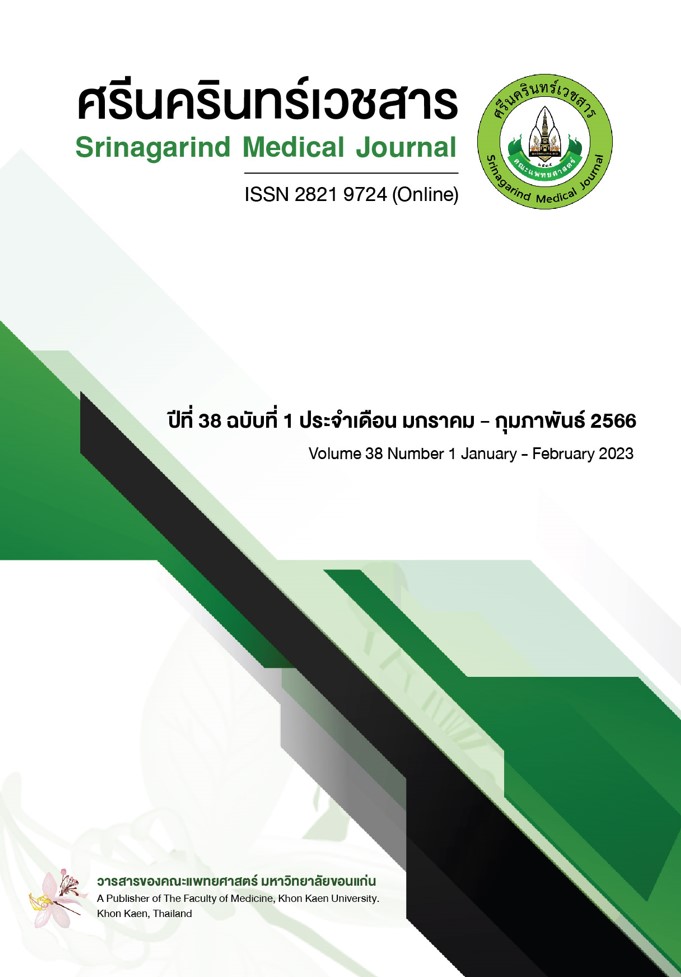ปัจจัยที่สัมพันธ์กับความสำเร็จในการป้องกันการคลอดทารกก่อนกำหนด ในสตรีตั้งครรภ์เดี่ยวที่มีประวัติคลอดทารกก่อนกำหนด หรือปากมดลูกไม่แข็งแรง
Abstract
Factor associated with the Successful Prevention of Preterm Birth in Singleton Pregnant Women with a History of Spontaneous Preterm Birth or Incompetent Cervix
หลักการและวัตถุประสงค์: ต้องการศึกษาปัจจัยที่สัมพันธ์กับความสำเร็จในการป้องกันการคลอดทารกก่อนกำหนด ในสตรีตั้งครรภ์เดี่ยวที่มีประวัติคลอดทารกก่อนกำหนด หรือปากมดลูกไม่แข็งแรง
วิธีการศึกษา: เป็นการศึกษา prognostic research, retrospective cohort design ในสตรีตั้งครรภ์เดี่ยวที่มีประวัติคลอดทารกก่อนกำหนด หรือปากมดลูกไม่แข็งแรง ฝากครรภ์ที่โรงพยาบาลมหาราชนครราชสีมา และคลอดในช่วงเดือนตุลาคม 2560 ถึงกันยายน 2563 ได้ 17-alpha-hydroxy-progesterone caproate; (17-OHPC) 250 มิลลิกรัม ฉีดเข้ากล้ามเนื้อทุกสัปดาห์ ตั้งแต่อายุครรภ์ 16 – 36 สัปดาห์ และตรวจวัดความยาวปากมดลูกทุก 2 สัปดาห์ ตั้งแต่อายุครรภ์ 16 – 24 สัปดาห์ เมื่อพบปากมดลูกสั้น (น้อยกว่า 25 มิลลิเมตร) ให้ทำการเย็บปากมดลูกทันที และในกลุ่มปากมดลูกไม่แข็งแรง ให้ทำการเย็บปากมดลูกในช่วงอายุครรภ์ 12 – 14 สัปดาห์ โดยไม่ต้องรอวัดความยาวปากมดลูก ร่วมกับให้ 17-OHPC ทุกสัปดาห์ตั้งแต่อายุครรภ์ 16 – 36 สัปดาห์ เพื่อป้องกันการคลอดก่อนกำหนด โดยเก็บข้อมูลอายุ ดัชนีมวลกาย การให้โปรเจสโตเจน การวัดความยาวปากมดลูก การเย็บปากมดลูก และอายุครรภ์ที่คลอด ซึ่งจะคัดออกจากการศึกษาเมื่อตรวจพบทารกมีความผิดปกติรุนแรง ไม่สามารถติดตามผลการคลอดได้ ทารกตายคลอด หรือมีความจำเป็นต้องให้คลอดก่อนกำหนดเนื่องจากภาวะแทรกซ้อนต่าง ๆ
ผลการศึกษา: สตรีตั้งครรภ์ 120 ราย ถูกคัดออก 6 ราย เนื่องจากจำเป็นต้องให้คลอดก่อนกำหนด เหลือเข้าสู่การศึกษา 114 ราย ซึ่งคลอดครบกำหนด 78 ราย (ร้อยละ 78.4) ไม่มีความแตกต่างของอายุ ดัชนีมวลกาย ความยาวปากมดลูก และการได้รับโปรเจสโตเจนในกลุ่มที่คลอดครบกำหนดหรือคลอดก่อนกำหนด โดยมีสตรีตั้งครรภ์ที่ได้เย็บปากมดลูกทั้งหมด 18 ราย คลอดครบกำหนด 12 ราย (ร้อยละ 66.7) ได้เย็บปากมดลูกที่อายุครรภ์เฉลี่ย 17.4 ± 4.1 สัปดาห์ โดยกลุ่ม incompetent cervix ได้เย็บปากมดลูกที่อายุครรภ์เฉลี่ย 15.2 ± 3.2 สัปดาห์ และกลุ่ม short cervix ได้เย็บปากมดลูกที่อายุครรภ์เฉลี่ย 20.5 ± 3.1 สัปดาห์ ซึ่งในกลุ่มที่คลอดครบกำหนดได้รับการเย็บปากมดลูกที่เร็วกว่าในกลุ่มที่คลอดก่อนกำหนดทั้้งหมดอย่างมีนัยสำคัญ
สรุป: ไม่พบความแตกต่างของอายุ ดัชนีมวลกาย และประวัติการตั้งครรภ์ครั้งก่อน ในสตรีตั้งครรภ์ที่คลอดครบกำหนดหรือคลอดก่อนกำหนด แต่พบแนวโน้มที่อาจทำให้การคลอดก่อนกำหนดเพิ่มขึ้น ได้แก่ การตรวจวัดได้ปากมดลูกสั้นตั้งแต่ครั้งแรก การเย็บปากมดลูกช้า หรือมีประวัติการคลอดก่อนกำหนดตั้งแต่ 2 ครั้งขึ้นไป และการเย็บปากมดลูกในอายุครรภ์ก่อน 16 สัปดาห์ โดยไม่ต้องรอวัดความยาวปากมดลูก อาจเพิ่มความสำเร็จในการป้องกันการคลอดทารกก่อนกำหนด
Background and Objective: To study the factors associated with the successful prevention of preterm birth in singleton pregnant women with a history of spontaneous preterm birth or incompetent cervix.
Materials and methods: This prognostic research, retrospective cohort design recruited singleton pregnant women with a history of spontaneous preterm birth or incompetent cervix, who had antenatal care at Maharat Nakhon Ratchasima Hospital and delivered between October 2017 and September 2020. They received 17-alpha-hydroxy-progesterone caproate; (17-OHPC) 250 mg intramuscular injection weekly from 16 – 36 weeks gestation and measured cervical length biweekly from 16 – 24 weeks gestation. They received a cervical cerclage immediately if short cervix (less than 25 mm). By the way, the incompetent cervix group could receive a cervical cerclage immediately at 12 – 14 weeks gestation without the measurement of cervical length and continued 17-OHPC 250 mg intramuscular injection weekly from 16 – 36 weeks gestation. Age, body mass index (BMI), progestogen administration, transvaginal ultrasound cervical length (TVU-CL), cervical cerclage, and delivery status were recorded. Pregnant women with severe fetal anomalies, unknown delivery status, stillbirth, and indicated preterm birth were excluded from this study.
Results: We recruited 120 cases in the study, but 6 cases were excluded. 114 cases were remaining in this study. 78 cases had term delivery (68.4%). There was no difference in age, BMI, cervical length, and progestogen administration between the term and preterm delivery groups. When analyzed in the cervical cerclage group (18 cases): 12 cases had a term delivery (66.7%). They received a cervical cerclage at 17.4 ± 4.1 weeks gestation: the incompetent cervix group was done at 15.2 ± 3.2 weeks gestation and the short cervix group was done at 20.5 ± 3.1 weeks gestation. There was a statistical significance that the term delivery group received a cervical cerclage faster than the preterm group. (p=0.022)
Conclusion: There was no difference in age, BMI, and previous pregnancy history between the term and preterm delivery groups. However, we found a trend that may increase preterm birth such as the short cervix at the first time, delayed cervical cerclage, or previous preterm birth ≥ 2 times. Nevertheless, cervical cerclage before 16 weeks gestation without waiting to measure cervical length may increase the prevention of preterm birth.
Downloads
Published
Issue
Section
License

This work is licensed under a Creative Commons Attribution-NonCommercial-NoDerivatives 4.0 International License.


